Memory Frequency Scaling in SFF Systems: An Investigation with SO-DIMMs and Coffee Lake
by Ganesh T S on November 28, 2018 8:00 AM ESTSPECworkstation 3 Benchmark
The ASRock DeskMini GTX Z370 is not specifically marketed as a workstation. However, with the increasing popularity of workstation notebooks as well as SFF systems targeting the market, it makes sense to study the effects of SO-DIMM characteristics on the performance of typical workstation workloads.
The SPECworkstation 3 benchmark measures workstation performance based on a number of professional applications. It includes more than 140 tests based on 30 different workloads that exercise the CPU, graphics, I/O and memory hierarchy. These workloads fall into different categories.
- Media and Entertainment (3D animation, rendering)
- Product Development (CAD/CAM/CAE)
- Life Sciences (medical, molecular)
- Financial Services
- Energy (oil and gas)
- General Operations
- GPU Compute
Individual scores are generated for each test and a composite score for each category is calculated based on a reference machine (HP Z240 tower workstation using an Intel E3-1240 v5 CPU, an AMD Radeon Pro WX3100 GPU, 16GB of DDR4-2133, and a SanDisk 512GB SSD). This composite score, also called as the SPEC Ratio, is presented in the graphs below for different categories.
One aspect to note here is that SPECworkstation 3 requires 190GB of free space on the disk from which it is run. The 240GB SSD in our configuration couldn't meet the requirements, and we had to use a 1TB SanDisk Extreme Pro NVMe 3D SSD for the benchmarks in this section.
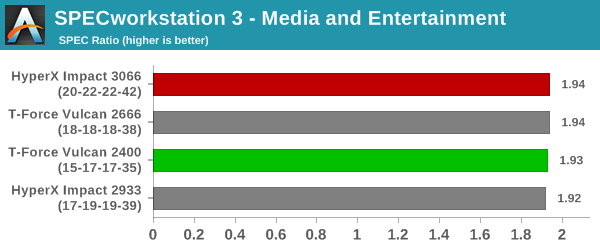
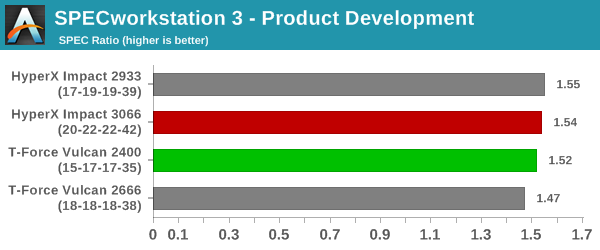
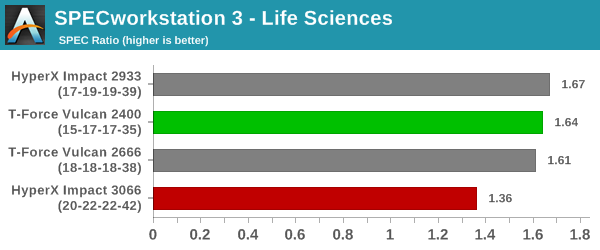

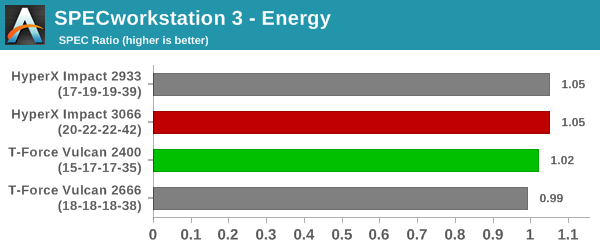

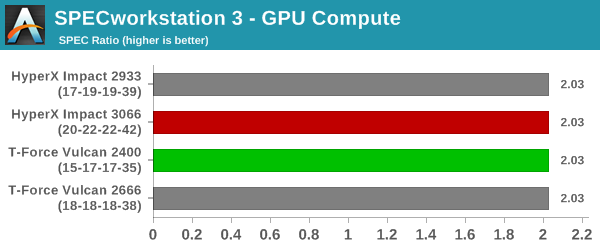
The official SPECworkstation 3 run results for the different configurations are linked below.
A look at the detailed scores from the links above also shows that the only anomalous number for DDR4-3066 in the Life Sciences category is due to the WPCStorage component for lammps workload (which should ideally not be affected by the DRAM in the system). Other than that, the behavior seen in the previous benchmark sections is repeated here. Either the scores are bunched very close together, or, the DDR4-2933 configuration comes out on top.










25 Comments
View All Comments
cygnus1 - Wednesday, November 28, 2018 - link
How does anyone look at those memory benchmarks and justify buying anything other than the cheapest RAM that meets minimum spec?Yuriman - Wednesday, November 28, 2018 - link
Pretty much agree. Good to know, though.nwrigley - Wednesday, November 28, 2018 - link
Yep. The only difference for me is that I only buy Crucial. This comes from personal experience of AMAZING customer support from them.I had one of their sticks die on me once after 8 years of use. I called in and was shocked to talk to someone in the US. Since they didn't make the same RAM I had anymore, they offered to replace all 4 sticks so that I had a matching set, even though 3 of the 4 sticks were fine. And since the replacements were slower timings without heat spreaders, they offered to double the capacity to cover the difference. They upgraded me from 4x 1-gig sticks of DDR2 to 4x 2-gigs of DDR2 without me raising any fuss - this was all customer services idea. That made me a customer for life.
cygnus1 - Wednesday, November 28, 2018 - link
Yeah, I too am a big Crucial fan because of reasons like this, from my experience as well. Not quite as generous as your story, but never any kind of trouble getting support for their hardware.But these benchmarks really show that performance should not be even remotely near the top of the list of reasons to pick one RAM part over another. Brand/warranty/customer service is a real way to differentiate and justify a given price.
koaschten - Wednesday, November 28, 2018 - link
I found this handy graphic on reddit some time ago:https://i.imgur.com/lbPIkiW.png
Looking at the tested offerings, it is obvious why there was so little performance gain, the Latency/clock relations are just off the chart, for the 3066 CL20 literally.
koaschten - Wednesday, November 28, 2018 - link
source: https://www.reddit.com/r/intel/comments/9mlwbn/ram...yes, this is DIMM not SO-DIMM, but shows the differences nicely.
willis936 - Wednesday, November 28, 2018 - link
It is somewhat frustrating to see all of this work done on a case that doesn't make sense to examine first.If the original question is "When does memory performance matter to CPUs?" then the place to start is at the extreme, not somewhere in the middle. If it was found that an 8 core 4 GHz x86 processor with whatever cache architecture and two channels of memory was memory bandwidth or latency starved THEN it would make sense to start moving down the stack and identify when it is no longer a concern. The conclusion to draw from this is much less meaningful to most any reader. There are like five people on the planet choosing between more expensive and cheaper memory kits for SFF systems.
GreenReaper - Thursday, November 29, 2018 - link
Might make more sense with AMD APUs. You'd probably get a much better return from overclocking the memory than the CPU, given how bandwidth-starved they can be.The_Assimilator - Wednesday, November 28, 2018 - link
Whatever happened to ranking memory by its performance rating, to determine how objectively good it is? For anyone who doesn't know/remember, performance rating = (memory frequency / CAS latency), and higher = better.It's sad that in this day and age, my 2x8GB DDR3-1600 CL8 (with no RGB LEDs or unnecessary heatsinks) has a higher PR than any of these DDR4 kits. It's even sadder that today's reviews of memory that "overclock" it, just concentrate on pushing up the frequency instead of trying to tighten the CAS timings, because the latter is where you'll see the most benefit.
nevcairiel - Wednesday, November 28, 2018 - link
All you are calculating here is the actual latency, since CAS latency is expressed in cycles. What this doesn't account for is the actual memory speed (ie. bandwidth).Just using your formula, a 1600/8 and 3200/16 module should be equal, right? But one of those offers twice the raw memory throughput, at about similar absolute latency (ie. performance rating).
It is a good idea to keep in mind that latency and frequency interact, but not in a way you suggest. Many people look at things like 3200 CL16 and 3600 CL18 and would instinctively say that the second set has a higher latency, while in reality the actual latency is quite similar, and you get more bandwidth.